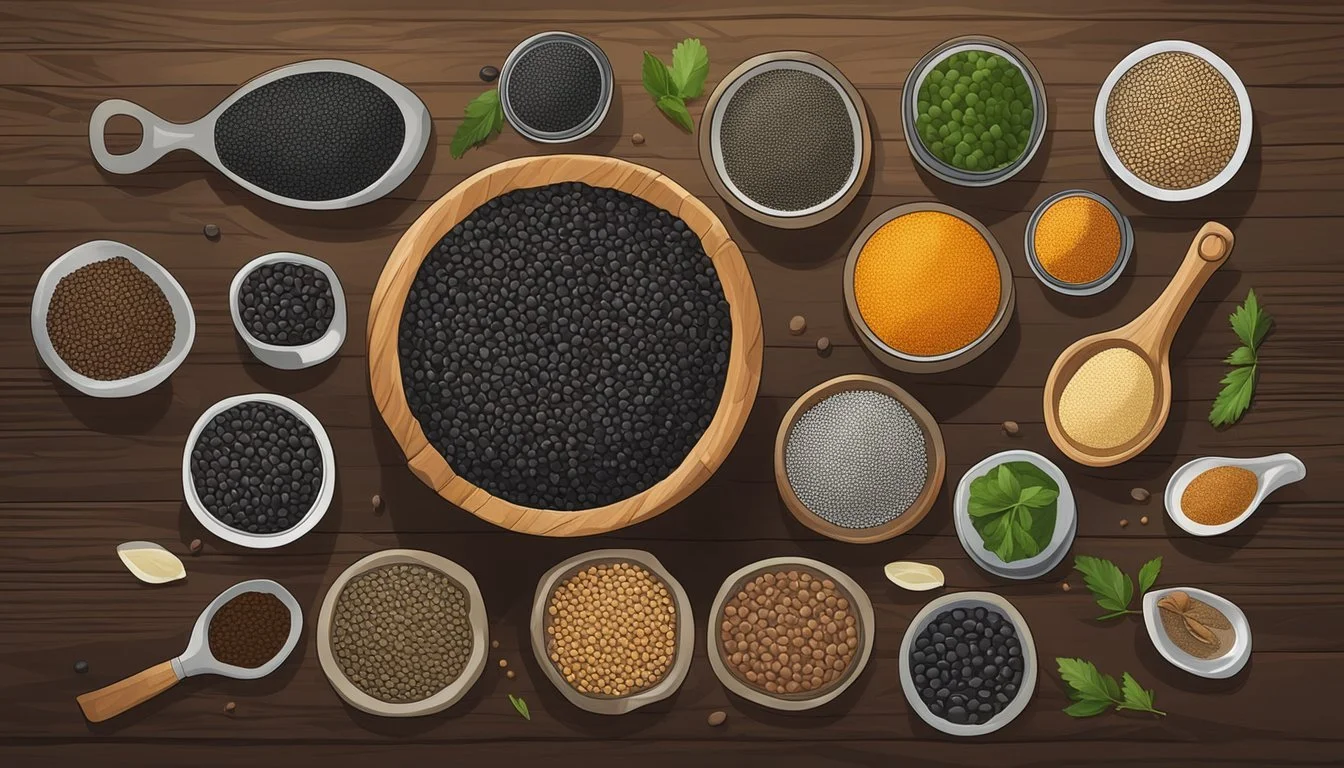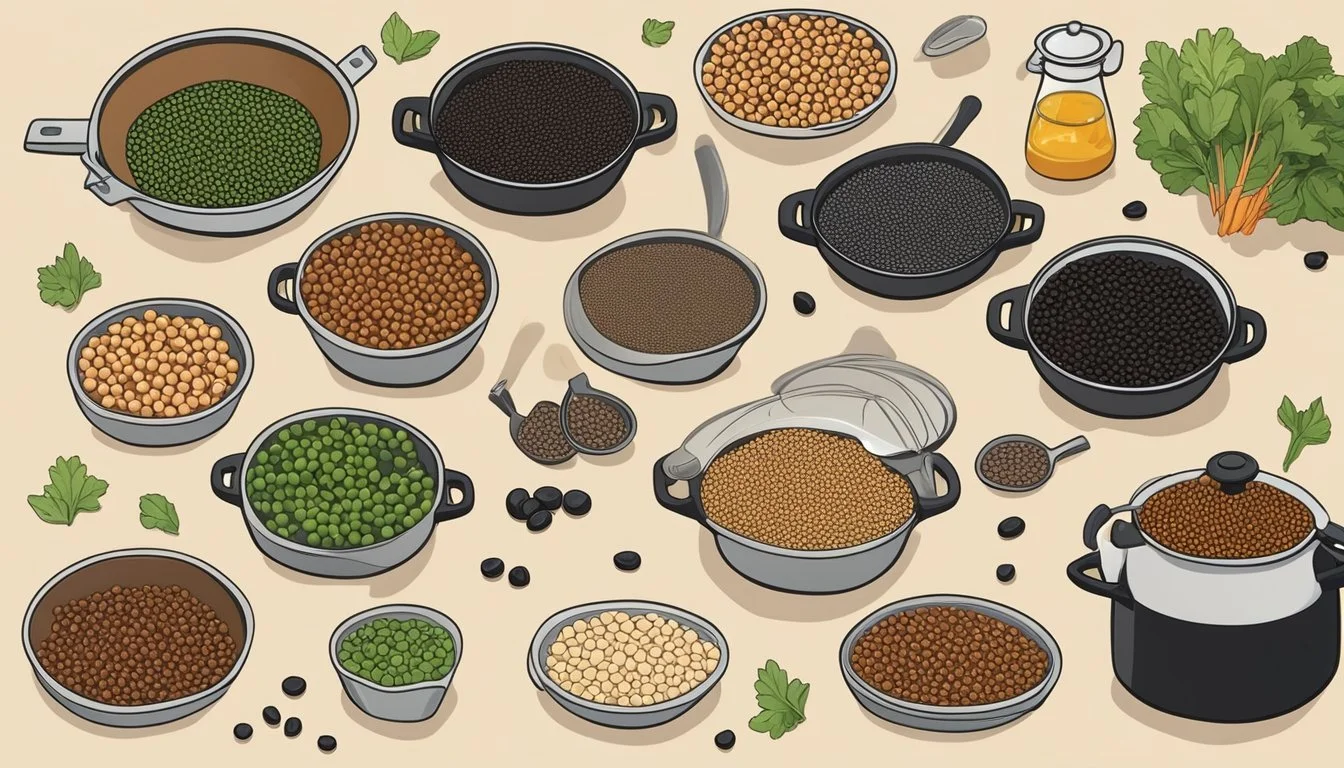Beluga Lentils Substitutes
Best Alternatives for Cooking
Beluga lentils, with their small, dark appearance and hearty texture, are a nutritional powerhouse, boasting high protein and fiber content. These legumes are prized for their ability to hold shape and add depth to a variety of dishes. If you're looking for substitutes, split peas and black beans are excellent alternatives as they offer similar textures and nutritional benefits.
Whether you're out of Beluga lentils or simply seeking variety in your meals, incorporating other legumes can maintain the healthy balance of protein and fiber in your diet. Split peas, for example, have a close flavor profile and comparable shape when cooked. They make a great stand-in for stews and salads where the lentils' structural integrity is essential.
Black beans, another suitable substitute, bring not just the necessary nutrition but also a rich, earthy flavor that complements many dishes. Substitute Beluga lentils with black beans to achieve a hearty texture and robust taste in soups, side dishes, and curries.
Understanding Beluga Lentils
Black Beluga Lentils, also known as Black Lentils, are named for their resemblance to Beluga caviar. These small, dark lentils are about ⅓ the size of typical lentils and prized for their rich, earthy flavor.
The texture of Black Beluga Lentils is firm even after cooking, making them ideal for dishes where lentils should hold their shape, such as salads.
In terms of cooking, it is simple to prepare these lentils. They typically require a shorter cooking time than other varieties. A basic method includes simmering them with water or broth and aromatic herbs until tender. They can be used in a variety of dishes, including soups, stews, and purees.
Beluga lentils are not just versatile but also highly nutritious. They are an excellent source of protein, making them a favorite in vegetarian and vegan diets. Each serving provides substantial amounts of iron and potassium, essential nutrients that support overall health.
Key Nutrients in Beluga Lentils:
Nutrient Amount per Serving Protein High Iron Significant Potassium Rich Source
These lentils also contain polyphenols and antioxidants, which are beneficial for overall well-being. They provide about ⅓ of the daily fiber requirement per serving, making them an excellent option for those looking to improve their dietary fiber intake.
When integrating Black Beluga Lentils into your meals, their firm texture and rich flavor can complement various ingredients, enhancing both the nutritional value and taste of your dishes.
Popular Substitutes for Beluga Lentils
When swapping out beluga lentils, several alternatives offer similar textures and flavors. These substitutes vary in cooking times and nutritional profiles, yet they can seamlessly replace beluga lentils in various recipes.
French Lentils
French lentils, or Puy lentils, are known for their firm texture and robust flavor. They hold their shape well after cooking, making them an excellent substitute in salads and side dishes.
Their earthy taste pairs well with savory ingredients. French lentils cook in about 20-25 minutes and require no soaking. They add a hearty element to dishes, similar to beluga lentils, with a slightly more pronounced, peppery flavor.
Black Beans
Black beans offer a creamy texture and mild flavor that makes them suitable for various dishes, including soups and stews. Although they require soaking and longer cooking times, they provide a protein-rich and nutritious alternative to beluga lentils.
When cooked, black beans develop a tender texture that can complement a range of ingredients. They are also versatile and easily absorb the flavors of the dishes they are included in.
Green Lentils
Green lentils are another practical substitute for beluga lentils. They have a firm texture that holds up well during cooking, making them suitable for salads, stews, and side dishes. Their slightly peppery and savory taste closely matches that of beluga lentils.
Cooking green lentils typically takes about 30-35 minutes. They do not require soaking and maintain their shape well, adding a similar hearty quality to various recipes.
Red Lentils
Red lentils, though different in color, offer a sweet, mild flavor and tender texture when cooked. They are particularly good in soups and curries, where they break down and create a creamy consistency.
Red lentils cook much faster than beluga lentils, usually in about 15-20 minutes, and do not require soaking. They work well in dishes where a smooth, thick texture is desired, providing a delicious and nutritious alternative.
Substituting Lentils in Different Cuisines
Substitutes for beluga lentils vary depending on the cuisine. It's important to consider the texture, flavor, and cooking time of the substitutes to maintain the authenticity of the dishes.
Indian Cuisine
In Indian cuisine, lentils are integral in dishes like dal and curries. When substituting beluga lentils, split peas or chickpeas can be effective replacements. Split peas, with their earthy flavor, work well in dals and simmer until they are soft, absorbing the rich spices like cumin and garlic.
Chickpeas, or chana, add a hearty texture to curries. They are perfect for dishes requiring a longer cooking time, allowing them to soak up the complex spice mixtures. Both substitutes are also high in protein, aligning with the nutritious profile of lentils.
Middle Eastern Dishes
Lentils are often used in Middle Eastern stews, soups, and salads. For soups, cannellini beans or split peas can be used. Cannellini beans, known for their creamy texture, make an excellent replacement in lentil soups, blending well with spices such as cumin.
Split peas can be a good substitute in stews and salads, offering a similar consistency and nutritional value. They cook faster than lentils, making meal preparation more efficient. Both ingredients hold up well in dishes that incorporate various vegetables and herbs typical in Middle Eastern cuisine.
Mediterranean Recipes
In Mediterranean recipes, lentils play a key role in soups, salads, and vegetable-based dishes. Replacement options like quinoa and chickpeas are excellent due to their texture and flavor profiles. Quinoa, with its slightly nutty taste, can replace lentils in salads, offering a similar protein content and a light, fluffy consistency.
Chickpeas, often featured in Mediterranean cuisine, can substitute lentils in vegetable-based dishes and soups. They work well with the region’s herbs and spices, such as garlic and cumin, ensuring the dish remains flavorful and nutritious. These substitutes maintain the health benefits and culinary integrity essential to Mediterranean cooking.
Nutritional Comparison of Beluga Lentils and Their Substitutes
When considering substitutes for beluga lentils, it's important to compare their nutritional content to ensure dietary needs are met. This comparison includes key nutrients like calories, fat, carbohydrates, fiber, and protein.
Beluga Lentils are known for their rich nutritional profile:
Calories: 180 per cup
Fat: 0.6g
Carbohydrates: 32g
Fiber: 9g
Protein: 13g
French Green Lentils are a common substitute:
Calories: 230 per cup
Fat: 0.8g
Carbohydrates: 40g
Fiber: 17g
Protein: 18g
Brown Lentils, another alternative, offer:
Calories: 230 per cup
Fat: 1g
Carbohydrates: 40g
Fiber: 15g
Protein: 18g
Red Lentils provide:
Calories: 226 per cup
Fat: 0.8g
Carbohydrates: 40g
Fiber: 15g
Protein: 18g
Each type of lentil offers a unique nutritional profile. French Green Lentils, for instance, have a higher fiber content compared to beluga lentils. Brown Lentils and Red Lentils contain similar amounts of calories and carbohydrates but slightly more protein.
By comparing the nutritional values, one can choose a substitute that aligns closely with the dietary requirements and preferences. This ensures that the meals prepared retain their nutritional integrity regardless of the type of lentil used.
Cooking Advice for Lentil Substitutes
Different lentil substitutes have varying textures and flavors, necessitating adjustments in cooking methods and times to achieve optimal results. Key considerations include soaking times, boiling, and steaming preparations.
Adjusting Cooking Times
Chickpeas: To replace lentils with chickpeas, consider their longer cooking time. Soak dried chickpeas overnight, then boil them for 1 to 1.5 hours until tender. For canned chickpeas, rinse them and cook for 15-20 minutes for a quicker option.
Quinoa: Quinoa cooks swiftly, making it an efficient lentil substitute. Rinse thoroughly, then boil for about 15 minutes. Steaming is also a preferred method; use a 1:2 ratio of quinoa to water and steam for approximately 20 minutes.
Beans: Beans like black beans and kidney beans require soaking and extended boiling. Soak them overnight and boil for 1-2 hours until soft. Canned beans shorten the process to about 20 minutes of simmering.
When substituting lentils with these ingredients, adjust your cooking times accordingly to maintain texture and flavor.
Incorporating Lentil Substitutes into Specific Dishes
Lentil substitutes like chickpeas, black beans, and cannellini beans can seamlessly replace lentils in various dishes. They bring unique textures and flavors, ensuring your meals remain nutritious and delicious.
Soups and Stews
Chickpeas and black beans work exceptionally well in soups and stews. Their firm texture stands up to long cooking times, providing a hearty consistency similar to lentils. Cannellini beans, with their creamy texture, are perfect for creating rich, velvety broths. To incorporate, soak canned beans directly or dried beans overnight before cooking. Adding these substitutes increases both the protein and fiber content, making the dish more nutritious and filling.
Salads and Side Dishes
For salads and side dishes, chickpeas and black beans offer a versatile option. Their robust texture and slightly nutty flavor pair well with fresh vegetables. Quinoa can also be utilized, adding a light, fluffy consistency and a protein boost. Simply cook quinoa according to package instructions before mixing it into your salad. Whether for vegan or vegetarian diets, these substitutes enhance the nutrition of your meals without sacrificing flavor.
Main Courses
In main courses, substitutes like tofu, chickpeas, and soybeans shine. Tofu, in particular, absorbs flavors well and mimics the texture of lentils in dishes like curries and casseroles. Chickpeas offer a nutty, robust flavor, providing a hearty base for vegetarian burgers or vegan loafs. Similarly, peanuts and quinoa can be used creatively, adding unique textures and protein to various main dishes. Incorporating these alternatives ensures a balanced meal with diverse nutritional benefits.
Culinary Tips for Enhancing Dishes with Lentil Substitutes
When substituting lentils in recipes, each alternative brings its unique texture and flavor. For the best results, consider the following tips to enhance any dish.
Chickpeas are a versatile substitute. For a richer flavor, roast them with spices like cumin, paprika, and garlic powder. This adds a crispy texture and an aromatic touch.
Cannellini beans provide a creamy texture. They pair well with herbs such as thyme, rosemary, and bay leaves. Adding these herbs during simmering enhances the beans' mild flavor.
Quinoa offers a complete protein option. Cook it in vegetable broth instead of water and incorporate spices like turmeric or curry powder for added depth. Toasting the quinoa lightly before boiling can also provide a nutty flavor.
Black beans, when mashed, can create a hearty, filling base for soups and stews. Season them with a mix of chili powder, cayenne, and fresh cilantro for a bold, zesty taste.
Here's a simple table to summarize spice pairings:
Substitute Recommended Spices/Herbs Chickpeas Cumin, Paprika, Garlic Powder Cannellini Beans Thyme, Rosemary, Bay Leaves Quinoa Turmeric, Curry Powder Black Beans Chili Powder, Cayenne, Cilantro
Roasting alternatives like chickpeas or black beans enhances their flavor. Drizzle with olive oil, season generously, and roast at 400°F until crispy.
Experimentation is key. Try different combinations of herbs and spices to discover your favorite flavor profiles. Each lentil substitute can transform a dish, making the meal both exciting and satisfying.







